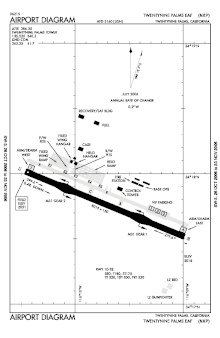Twentynine Palms Strategic Expeditionary Landing Field
Twentynine Palms Strategic Expeditionary Landing Field[2][3] or Twentynine Palms SELF[1] (ICAO: KNXP, FAA LID: NXP) is a military use airfield located nine nautical miles (17 km) northwest of the central business district of Twentynine Palms, a city in San Bernardino County, California, United States.[1] The SELF is the largest expeditionary airfield (EAF) operated by the United States Marine Corps.[2] It is also known as the Twentynine Palms EAF[4] and is located at the Marine Corps Air Ground Combat Center (MCAGCC) Twentynine Palms.[5]
Twentynine Palms SELF | |||||||||||
|---|---|---|---|---|---|---|---|---|---|---|---|
 USGS aerial image - 22 May 1994 | |||||||||||
| Summary | |||||||||||
| Airport type | Military | ||||||||||
| Owner | U.S. Navy[1] | ||||||||||
| Operator | U.S. Marine Corps | ||||||||||
| Location | San Bernardino County, near Twentynine Palms, California | ||||||||||
| Elevation AMSL | 2,051 ft / 625 m | ||||||||||
| Coordinates | 34°17′46″N 116°09′44″W | ||||||||||
| Website | www.29palms.usmc.mil | ||||||||||
| Runways | |||||||||||
| |||||||||||

History
History of the EAF
The history of the Expeditionary Airfield (EAF) and its supporting units is closely interwoven. In March 1977, General Louis H. Wilson, the 26th Commandant of the Marine Corps, activated the EAF. The initial unit placed in charge of the EAF was designated Detachment MABS-11. Two years later, in July 1979, Detachment MABS-11 became operationally attached to Marine Wing Support Group 37 (MWSG-37) and was redesignated MWSG-37, Detachment Bravo in 1982. Originally, only a cadre of Marines provided caretaker support for the EAF between exercises. However, during October 1988 MWSS-173 was transferred from MCAS Kaneohe Bay to the Marine Corps Air Ground Combat Center, Twentynine Palms in support of the EAF. On 4 March 1993, MWSS-173 was deactivated and Aviation Ground Support Element (AGSE) was activated to continue operating and maintaining the EAF. On 1 April 1999, AGSE deactivated and was redesignated as Marine Wing Support Squadron 374(- reinforced) (MWSS-374). Currently the squadron is over 700 strong, and possesses the ability to operate a tactical airfield including air traffic control services and maintaining ground and weapons support equipment for aircraft.[6]
EAF 29 Palms
The 29 Palms EAF is under operational control of the Commanding General, Third Marine Aircraft Wing. Day-to-day operations are the responsibility of the Marines of MWSS-374. The EAF was built in 1976 to test the Naval services aluminum expeditionary runway concept. The austere EAF is an example of what Naval aviation would use in a tactical situation where no prior airfield exists. It is a cornerstone of the Marine Corps' Combined Arms Exercise (CAX) Program. Today's EAF has changed very little since the original construction. Over three million square feet of aluminum AM-2 matting make up the primary runway, taxiways, and parking areas. The EAF operates as a "host nation" airfield to which deployed units bring their own organic support. Support functions provided at the EAF include the following: Airfield Operations, Air Traffic Control, Airfield Construction, Maintenance and Repair, Aircraft Rescue and Fire Fighting, Common Aviation Support Equipment, Explosive Ordnance Disposal, Weather Services, Communications, Aircraft Refueling, Fuel Storage, Engineer Support, and Motor Transport.[6]
Facilities
Strategic Expeditionary Landing Field (SELF) is a military airfield with an aluminum matted surface that is designed for sustained operations in an amphibious objective area.[7] The runway, taxiways, and aircraft parking areas are constructed entirely of AM-2 aluminum matting.[2] The AM-2 surface matting is a fabricated aluminum panel 1.5" thick, which consists of a hollow, extruded, one-piece main section with extruded end connectors welded to each end. The top surface of the AM-2 matting is coated with a non-skid material.[1]
The runway is 8,000 by 150 feet (2,438 by 46 m) and can accommodate the largest aircraft in the military inventory: the C-5 Galaxy and C-17 Globemaster. In a normal year, Marine Wing Support Squadron 374 operates the SELF 300 days, conducts 3,600 hours of flight operations, supports 16,647 aircraft, and pumps over five million gallons of jet fuel.[2]
References
- FAA Airport Form 5010 for NXP PDF. Federal Aviation Administration. Effective 27 August 2009.
- "2007 Internal Economic Facts & Figures" (PDF). Marine Air Ground Task Force Training Command / Marine Corps Air Ground Combat Center. 2007. Retrieved 26 October 2009.
- "Adding fuel to the firepower; Yuma's VMA-214 trains for Afghanistan". Press release. U.S. Marine Corps. 2 April 2009. Retrieved 26 October 2009.
- "KNXP - Twentynine Palms EAF". Federal Aviation Administration, via AirNav. 30 August 2007. Archived from the original on 30 September 2007.
- "About MCAGCC". MCAGCC/MAGTFTC 29 Palms CA. Archived from the original on June 11, 2009. Retrieved 26 October 2009.
-
 This article incorporates public domain material from websites or documents of the United States Marine Corps."MWSS-374 History". Marine Wing Support Squadron 374, official website. Archived from the original on 8 February 2010. Retrieved 26 October 2009.
This article incorporates public domain material from websites or documents of the United States Marine Corps."MWSS-374 History". Marine Wing Support Squadron 374, official website. Archived from the original on 8 February 2010. Retrieved 26 October 2009. - Conaway, Michael H. / Georgia Institute of Technology, School of Civil Engineering (June 1983). "Chemical Stabilization of Subgrade Soil for the Strategic Expeditionary Landing Field". Defense Technical Information Center. Archived from the original on 27 February 2012. Retrieved 26 October 2009.
{{cite web}}: CS1 maint: multiple names: authors list (link)
External links
- Aerial photo as of 22 May 1994 from USGS The National Map via MSR Maps
- FAA Airport Diagram for Twentynine Palms SELF (NXP) (PDF), effective October 5, 2023
- FAA Terminal Procedures for Twentynine Palms SELF (NXP), effective October 5, 2023
- Resources for this U.S. military airport:
- FAA airport information for NXP
- AirNav airport information for KNXP
- NOAA/NWS latest weather observations
- SkyVector aeronautical chart for KNXP